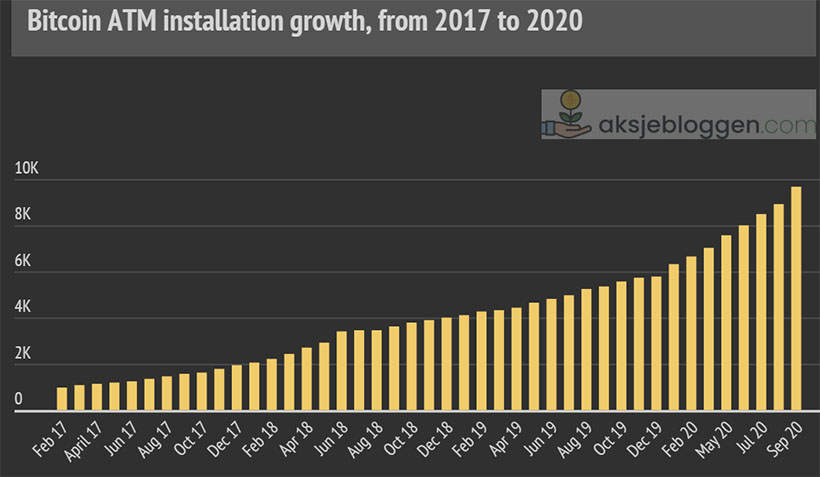Bitcoin Fundamentals Briefing, September 2020

In September, the major factors driving cryptocurrencies in general, and Bitcoin in particular, were and continue to be the same as those moving other markets (e.g., stocks, bonds, FX).
Right now, the overall mood is shaped by the COVID 19 situation, the fear of new lockdowns, and global economic performance statistics. Politics also play a role because when investors are nervous, they run toward quality, thereby increasing the demand for USD. In this climate, it’s only natural that Bitcoin would be impacted, not directly perhaps, but indirectly by the strength of the US dollar. In fact, the recent drop was a result of all this – the demand for USD due to the poor Fed statement in September, the lack of additional fiscal stimulus, the slowdown of global recovery (as recent EU data shows), and the upcoming US elections.
The consideration of major economic factors is beyond the scope of these reports. Nevertheless, our long-term readers, and those who read our weekly fundamental reports on EUR and Gold, have an excellent awareness of these factors since we examine them on an ongoing basis.
Here, we focus on events that seem important to Bitcoin’s performance, impacting market sentiment and shaping its long-term trajectory. We will use statistics to gauge whether the feeling has changed. Our readers may recall that – in last month’s report – we concluded that the overall situation was positive and looking promising in the long-term.
Major events
Large Swiss insurance company Atupri starts accepting Bitcoin and Tezos
Caroline Meli, Head of Marketing and Sales at Atupri Health Insurance, which serves 200,000 clients annually, made the following announcement:
“We are the first Swiss health insurer to accept cryptocurrency. Now you could pay with Bitcoin and Tezos. Our company does not own Bitcoins. The payment in Swiss francs will be calculated in real time. Thanks to Bitcoin Suisse, we are not exposed to financial risks.”
The company’s sales in 2019 amounted to almost $887 million. It’s interesting to note here that Bitcoin Suisse holds more than $1 billion in assets.
Bitcoin is now the 6th largest world currency
BTC’s market capitalization (defined as its circulating supply multiplied by the value of each unit) has skyrocketed to more than $200 billion, making it not only the largest cryptocurrency ever, but also larger than many fiat currencies.
According to a report published on Decrypt.co, after more than a decade of growth, Bitcoin ranks among the ten largest world currencies. The USD, EUR, CNY, JPY, and INR are the only currencies with a larger money supply than Bitcoin.
Installation of crypto ATM: BaFin approval required
Germany’s Ministry of Finance has set the rules for Crypto ATM operation and placement. According to BaFin.de:
“Proprietary trading is a financial service, while financial commission business is a banking business, for which prior approval from BaFin is required in accordance with Section 32 (1) KWG.”
Crypto exchanges reached a 14-month high in August
On September 8, TheCryptoblock.com reported:
- “August was a record-breaking month for metrics tracked by The Block.
- Total adjusted on-chain volume, which is a proxy for economic throughput, saw an increase of 38.3% in August to ~$125B, which is a 30-month high.
- Cryptocurrency traded volumes saw a nearly 75% increase in August, the largest month-over-month increase since February 2018, a 31-month high.
- Transaction fees on Ethereum increased significantly and reached an all-time high of over 40.5% of the total revenue, compared to 10% in May.”
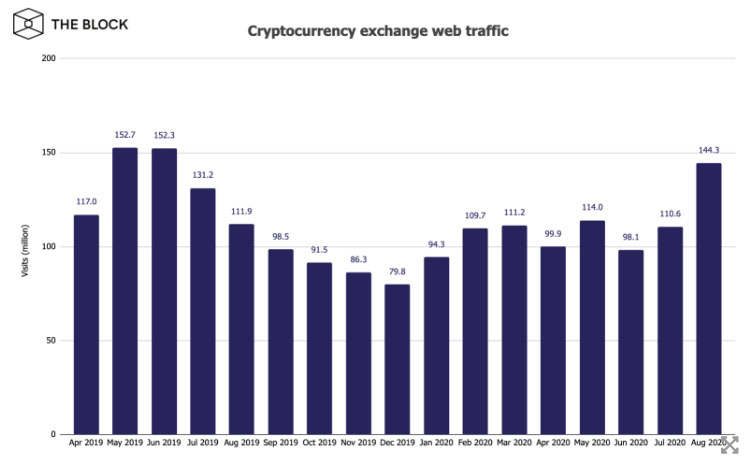
Swiss law reforms make crypto respectable
Bitcoin used to be associated with crime and money laundering. Now, Switzerland has amended its legal code to welcome cryptocurrencies and blockchain technology into the mainstream. The Senate quickly passed a wide range of financial and corporate law reforms. The “Blockchain Act,” as it is called, sailed through the House of Representatives in the summer. The law will likely come into effect in early 2021. As Heinz Tännler, President of the Swiss Blockchain Federation, stated:
“As of next year, Switzerland will have a regulatory framework that is among the most advanced in the world.”
Société Générale-Forge selects Tezos
On September 15, Nomadic Labs announced that Société Générale-Forge selected the Tezos blockchain for Central Bank Digital Currency (CBDC) experiments. The press release mentioned that, in July, Banque de France had selected Société Générale-Forge as part of its call for applications to experiment the use of CBDC for interbank settlements. As Michel Mauny, President of Nomadic Labs, stated:
“The Tezos project, strengthened by its technical capabilities, its adaptability, and its strong community, is already present in various projects, both in France and abroad. We are especially pleased to see this technology selected by Société Générale-Forge, and to reaffirm, once again, that the quality and expertise of our engineering is rewarded.”
Crypto trading volumes for August saw the biggest increase
According to The Block’s volume index, in August, crypto trading volumes saw the biggest month-over-month increase since February 2018, some 75%. Momina Khan posted on September 12:
“August’s volume clocked in at $191.2 billion compared to $109.3 billion in July, according to the August 2020 report by The Block Research. August’s spot exchange volume was the third-highest monthly volume since 2017, per the report.
Binance had the largest market share, amounting to roughly 65% of the total traded volume in August, followed by Coinbase (11.2%), Kraken (4.8%), and LMAX Digital (4.8%), among others.”

Another record day for Bakkt
On September 15, Bakkt tweeted:
“Another record day in the books for our physically-delivered futures: 15,955 Bakkt Bitcoin Futures were traded today, representing over $200 million of volume and a 36% increase from our previous all-time high.”
Kraken wins bank charter approval
On their blog, Kraken posted the following on September 16:
“We are thrilled to announce that the State of Wyoming has approved Kraken’s application to form the world’s first Special Purpose Depository Institution (SPDI), tentatively called Kraken Financial,’ said David Kinitsky, CEO of Kraken Financial. “This new institution will be regulated in largely the same manner as other US banks.’”
Bank of International Settlement (BIS) seeks blockchain experts
With centers located in Switzerland, Hong Kong SAR and Singapore, and new ones to be opened in Toronto, London, Frankfurt, Paris, and Stockholm, together with a strategic partnership in New York, the BIS Innovation Hub (BISIH) explores and promotes technological innovation in the financial sector. On their site, the BIS recently announced vacancies for Adviser DLT / Blockchain – Software Engineers and Solution Architects.
Coin ATM numbers increase
In recent months, we have seen a surge in the number of Bitcoin ATMs operating worldwide, as one of the most convenient and quick ways to transfer physical cash into Bitcoin or other cryptocurrencies. According to Coin ATM Radar, the current number of ATMs exceeds 10,000 globally and shows a 167% year-on-year jump, according to AksjeBloggen.
Big European states call for cryptocurrency curbs to protect consumers
Germany, France, Italy, Spain, and the Netherlands have called on the European Commission to draw up strict regulation for asset-backed cryptocurrencies like stablecoins to protect consumers and preserve state sovereignty in monetary policy. The finance ministers of the five European Union member-states said in a joint statement that stablecoins should not be allowed to operate in the 27-member bloc until legal, regulatory, and oversight challenges have been addressed. French Finance Minister Bruno Le Maire said:
“We’re waiting for the Commission to issue very strong and very clear rules to avoid the misuse of cryptocurrencies for terrorist activities or for money laundering. The central bank, I mean the ECB, is the only one to be allowed to issue a currency. And this point, it’s something that cannot be jeopardized or weakened by any kind of project including the so-called Libra project.”
EU to introduce crypto-assets regime by 2024
Europe has long sought “homegrown” alternatives to the likes of MasterCard and Visa, the US payments firms heavily used in the region. The European Union will introduce new rules within four years to make cross-border payments quicker and cheaper through the use of blockchain and crypto assets like stablecoins. As EU documents indicate:
“By 2024, the EU should put in place a comprehensive framework enabling the uptake of distributed ledger technology (DLT) and crypto-assets in the financial sector. It should also address the risks associated with these technologies.
By 2024, the principle of passporting and a one-stop shop licensing should apply in all areas which hold strong potential for digital finance.”
Instant payment systems should become the “new normal” by the end of 2021.
The Norwegian Government Pension Fund now indirectly holds 577.6 BTC
“Through its ownership stakes in MicroStrategy (1.51% as of December 31st 2019), the Norwegian Government Pension Fund now indirectly holds 577.6 Bitcoin (~57.5 MNOK, 6.3m USD),” Arcane Research tweeted on September 19.
MicroStrategy purchased 21,454 BTC at an aggregate purchase price of $250 in August with new reserve management strategy.
China needs first mover advantage in digital currency race
An article published in China Finance, a magazine run by the People’s Bank of China (PBOC), said the following:
“China needs to become the first nation to issue a digital currency in its push to internationalise the yuan and reduce its dependence on the global dollar payment system.”
SEC (OCC) lets banks to deposit and hold stablecoins collateral
In a public statement released on September 21, the SEC said:
“The Securities and Exchange Commission Strategic Hub for Innovation and Financial Technology Staff (FinHub Staff) issues this statement on an interpretation published by the Office of the Comptroller of the Currency (OCC Interpretation) addressing the authority of national banks and federal savings associations to hold stablecoin reserves. The OCC has limited its Interpretation to holding reserves of a stablecoin associated with hosted wallets that is backed by a single fiat currency and redeemable by the holder of the stablecoin on a 1:1 basis for the underlying fiat currency upon submission of a redemption request to the issuer.”
Institutional investors say they’ll buy more Bitcoin
According to Decrypt.co, pension funds and insurers might increase their crypto investments. Andrew Hayword writes:
“A new report from cryptocurrency insurance company Evertas suggests that institutional investors plan to increase their focus on crypto assets in the next five years.
Evertas surveyed investors that oversee some $78.4 billion worth of collective assets, and 64% of respondents reported that they expect a slight rise in crypto investments from the likes of pension funds, family officers, insurers, and sovereign wealth funds.
Meanwhile, a further 26% of respondents believe they will ‘dramatically’ increase their investments in Bitcoin and other cryptocurrencies over the next five years. All told, that’s 90% of surveyed institutional investors that expect some increase in crypto holdings in the next half-decade.”
Market statistics
Grayscale assets under management exceed $ 6 billion
In our report in July, we looked at the fundamental valuation of Bitcoin and came to conclusion that it is fair. At the same time, we predicted a positive climate for the foreseeable future. Bloomberg analysts agree that Grayscale funds are growing at a solid tempo and that they will buy all newly-mined Bitcoins to satisfy growing investors’ interest for new non-traditional investments. They pointed to 20K as a probable medium-term destination level for the market – this is what we are seeing right now.
Exchange “whale” ratio hits year low
A tweet by Ki Young Ju reported on September 17, “Exchange Whale Ratio hits the year low – the fewer whales moving to exchanges, the less dumping, and makes the higher BTC price.”
The Exchange Whale Ratio is the relative size of the top 10 inflows to total inflows by day of each exchange. Here, the weighted average for all exchanges is used.
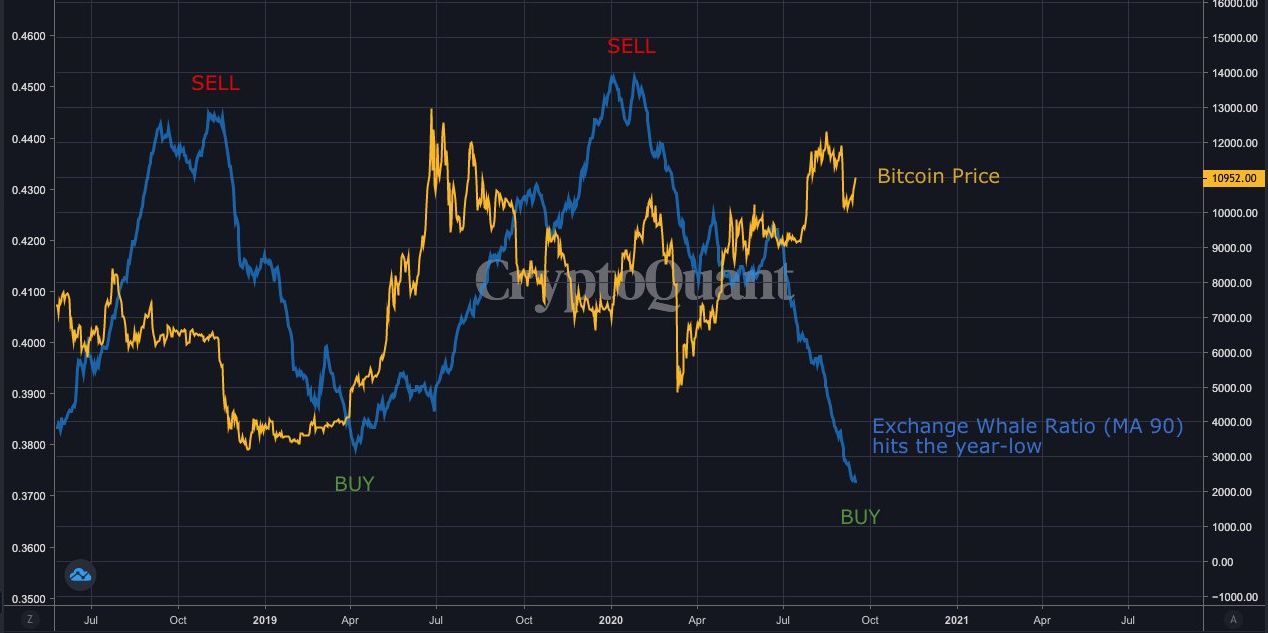
A tweet by Ki Young Ju reported on September 20, “Some miners began selling at the end of July, but in the long-run, they didn’t sell enough to stop the next bull-run.”
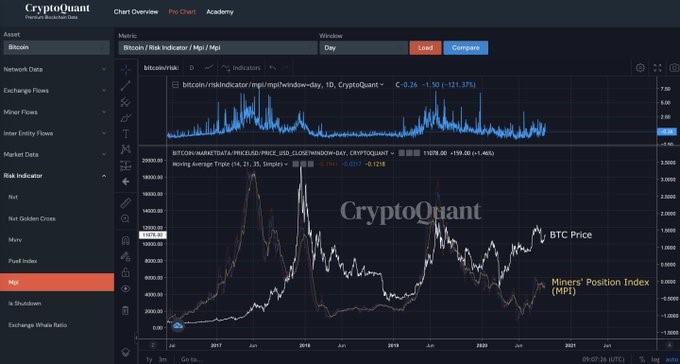
The Miners’ Position Index (MPI) is defined as the ratio of an amount of all miners’ outflows in USD divided by its 365-days moving average (this indicator is inspired by Puell Multiple).
Bitcoin’s hash rate hits new high

Grayscale released a very helpful report that presents the different approaches to Bitcoin valuation. Based on the most reliable approach, which in our opinion is “BTC Production Value,” Grayscale arrives at approximately the same results as JP Morgan and Bloomberg analysts did two months ago. The report states:
“The Bitcoin network’s electricity consumption can be used to calculate the production cost per Bitcoin. The relationship between price and production cost is important because it provides clues about miner profitability, which is a critical input to value analysis. As Bitcoin’s price increases, profitability tends to increase, enticing miners to expend more energy. Conversely, when profitability decreases, inefficient miners are often forced to sell their Bitcoin and turn off their equipment. This allows more efficient, well-capitalized miners to accumulate more Bitcoin rather than assume the role of the market’s natural seller. Because these miners are better capitalized, they may have the flexibility to hold Bitcoin in hopes of price appreciation.”
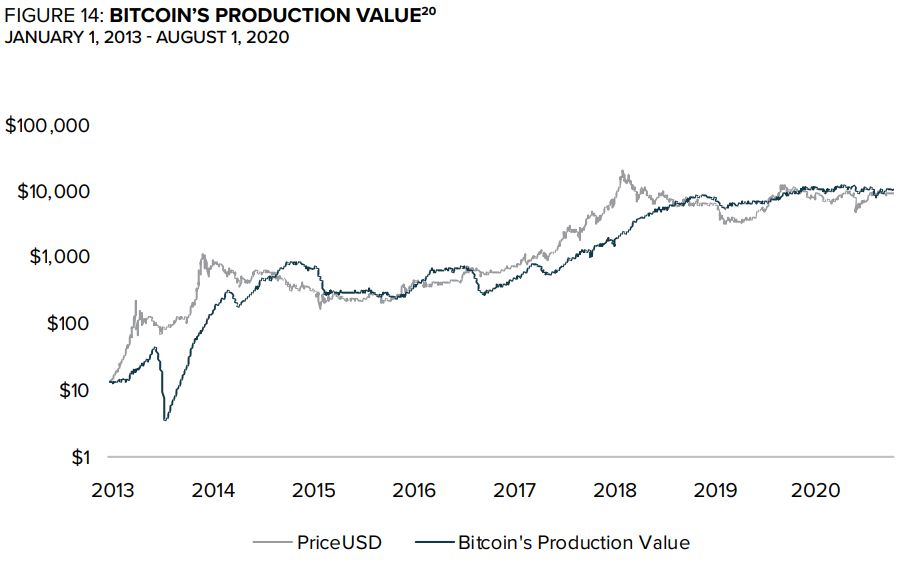
Regarding the Whale Index, Greyscale’s report states the following:
“The “Whale” Index, which counts the number of unique Bitcoin addresses with balances over 1,000 Bitcoins (approximately $11 million as of July 30, 2020), is sitting near all-time highs as shown in the chart below. An address can be thought of as an account or wallet, but users can have multiple addresses. Therefore, one individual can be the owner of multiple addresses in the Whale Index. The figure below illustrates an increasing number of addresses with large amounts of Bitcoin, a trend that indicates accumulation.”
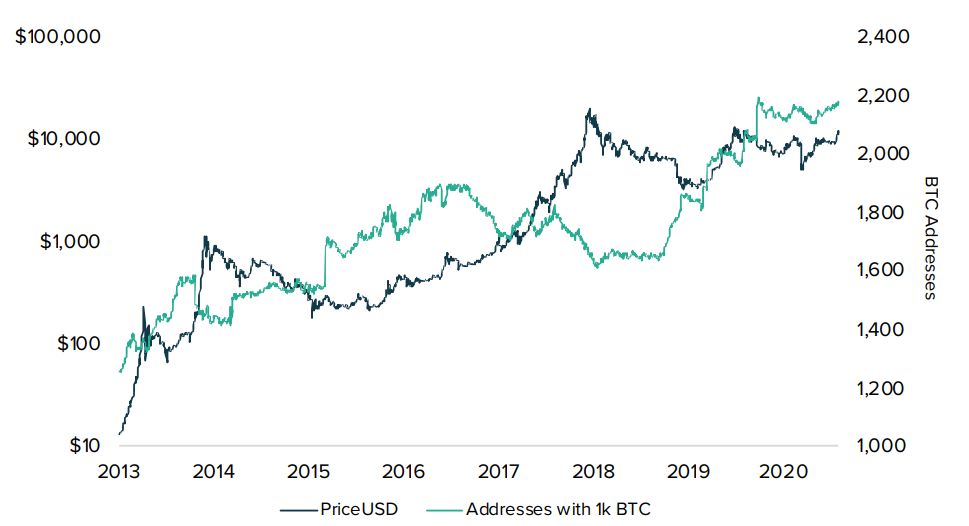
A dry September
This month, the Bitcoin market has not seen one outstanding event or factor that could impact the sentiment substantially and make us say, “This is it!”
The market was sensitive to factors common to the economy and moved in the same direction as other dollar-related markets, the stock market in particular. In fact, Bitcoin reconfirmed its correlation to stocks because – as nervousness and uncertainty rise – the Volatility Index (VIX) starts to grow. To sum up the situation in the words of a friend from Chicago, “Be prepared for a bumpy ride,” as we move closer to the US election – accordingly, the VIX and BTC’s correlation to the stock market will likely increase.
At first glance, September’s events seem lackluster and not directly related to the crypto market itself. Yes, right now, the markets are busy with Fed comments, a possible 2nd wave of COVID 19 lockdowns, and supportive fiscal measures. However, let’s take a closer look at what is going in the background…
Central banks (!!!) and big Swiss companies are adopting new rules for cryptocurrencies. Even the EU has made a statement concerning plans about crypto. This is remarkable because Switzerland is the heart of global banking; it does not adopt something casually. When such institutions take steps, their actions carry great significance, indicating the new place of cryptocurrencies in the financial system. We could say the same about the rush toward the creation of CBDC by the PBOC, Bank of France, and ECB. Again, this can hardly be described as light interest or the result of a trend. Be assured that a significant amount of work preceded such moves, statements, and interest.
Despite short-term fluctuations, statistics also show that interest in Bitcoin holds strong, mostly as accumulation in the medium-term. We suspect that demand could start to rise closer to the US election. We are treating the current drop as a temporary retracement in a long-term bull trend, which should continue in a few months. Readers who want further information can refer to our regular updates on the forum.
Despite temporary difficulties and a short-term downside tendency, we have no doubt that we will see a moderately bullish sentiment and perspective within a few months. Also, we do not see any technical and fundamental factors or reasons pointing to the opposite.
Author Profile

Sive Morten
At the Forex Peace Army, he is known as an author of Forex Military School, which quite unique free forex trading course. We do not know of any other free forex trading education covering such a broad spectrum of forex market concepts in such details while keeping it easy to understand and practically use.
As if that wasn't enough, he is the part of the Shoulders of Giants Program. He shares with his fellow traders at FPA his view and forcast of the Gold Market, Currency Market, and Crypto Market in form of weekly analytics and daily video updates.
* Complete Forex Trading Course by Sive Morten >>
* Sive Morten Forex , Gold , and Crypto Analysis >>
Info
873 Views 0 CommentsComments
Table of Contents
Recent
-
The Future of Money: How Bitcoin is Changing Personal Finance Skills Bitcoin Fundamental Briefing, April 2024 Bitcoin Fundamental Briefing, March 2024 Demystifying Cryptocurrency Nodes: Deep Dive into Polygon Node Ecosystem Strategies for Trading Forex on a Budget Bitcoin Fundamental Briefing, February 2024 Bitcoin Fundamental Briefing, January 2024 Strategic Asset Allocation Techniques for Currency Traders
